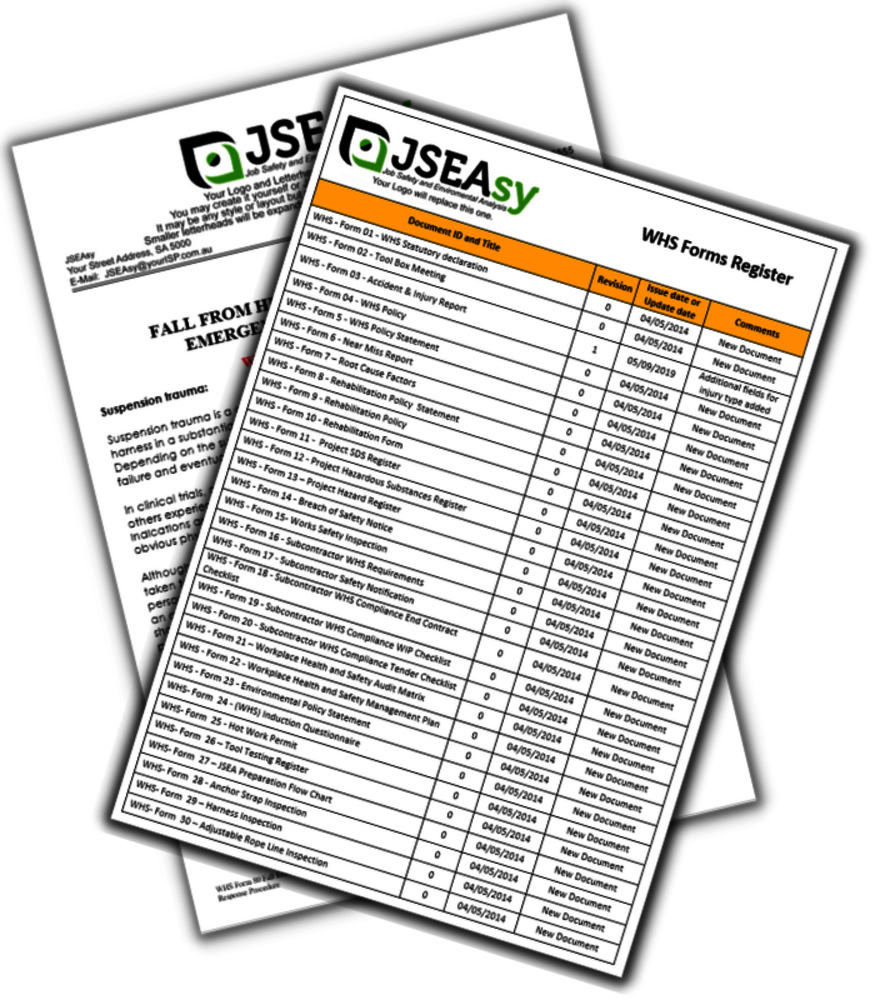Fall from Heights Rope Access Emergency Response Procedure.
This document will help you to have rescue procedures before any work commences heights.
Suspension trauma is a condition (e.g. following a fall), whereby a person suspended in a harness in a substantially upright position may experience blood pooling in the legs. Depending on the susceptibility of the individual, this may lead to loss of consciousness, renal failure and eventually death.
Having a Fall from Heights Rope Access Emergency Response Procedure is crucial for ensuring the safety and well-being of workers who are involved in rope access or any work conducted at height. Here’s why it’s essential:
Immediate Response to Emergencies
- Quick Rescue Operations: In the event of a fall or other emergency while working at heights, time is of the essence. A well-defined procedure ensures that rescue operations can be carried out swiftly and effectively, minimizing the risk of serious injury or fatality.
- Preparedness for Complex Scenarios: Rope access work often involves complex environments, such as tall buildings, industrial structures, or remote locations. A specific emergency response procedure addresses the unique challenges of these scenarios.
Minimizing Risk of Suspension Trauma
- Addressing Suspension Trauma: When a worker is suspended in a harness after a fall, they are at risk of suspension trauma, which can be life-threatening if not addressed quickly. A Rope Access Emergency Response Procedure outlines steps to prevent or mitigate this risk, such as positioning and prompt rescue.
- Ensuring Proper Handling: The procedure ensures that rescuers are trained to handle the situation correctly, reducing the risk of exacerbating injuries or causing further harm.
Ensuring Compliance with Safety Regulations
- Meeting Legal Requirements: Many safety regulations and standards mandate that employers have a specific emergency response plan for work at heights. Having a Rope Access Emergency Response Procedure helps you comply with these regulations, avoiding potential fines and legal consequences.
- Demonstrating Due Diligence: A documented procedure shows that the organization is proactive in managing risks associated with rope access work, fulfilling its duty of care to employees.
Protecting Worker Safety and Well-Being
- Reducing Anxiety Among Workers: Knowing that a well-prepared emergency response plan is in place can reduce anxiety among workers, allowing them to focus on their tasks without fear of inadequate support in case of an emergency.
- Providing Lifesaving Measures: The procedure ensures that lifesaving measures are in place, including the availability of trained personnel, appropriate equipment, and clear communication channels.
Effective Coordination During Emergencies
- Streamlining Rescue Efforts: A clear procedure ensures that all team members know their roles and responsibilities during an emergency, leading to coordinated and efficient rescue efforts.
- Facilitating Communication: The procedure includes guidelines for communication between workers, rescue teams, and emergency services, ensuring that everyone involved is informed and aligned.
Supporting Specialized Training and Equipment Use
- Ensuring Proper Training: Rope access and working at height require specialized skills. The emergency response procedure ensures that workers and rescuers are properly trained in the use of rescue equipment and techniques.
- Readiness of Equipment: The procedure outlines the necessary rescue equipment and ensures it is readily available, properly maintained, and appropriate for the specific work environment.
Mitigating Potential Legal and Financial Consequences
- Reducing Liability: In the event of an incident, having a Rope Access Emergency Response Procedure in place can help protect the organization from liability by demonstrating that all reasonable precautions were taken.
- Avoiding Operational Disruptions: Effective emergency procedures can minimize the impact of an incident on operations, reducing downtime and associated financial losses.
Enhancing Overall Safety Culture
- Promoting a Safety-First Mindset: Implementing and regularly reviewing the procedure fosters a culture of safety within the organization, emphasizing the importance of preparation and vigilance when working at heights.
- Encouraging Continuous Improvement: Regular drills and evaluations of the emergency response procedure encourage continuous improvement in safety practices and protocols.
Tailoring to Specific Work Environments
- Addressing Unique Risks: Different work environments present different challenges. A tailored Rope Access Emergency Response Procedure ensures that the specific risks of each job site are considered and mitigated.
- Adapting to Changing Conditions: The procedure provides guidelines for adapting the response plan to changing conditions, such as weather, structural changes, or new hazards.
In summary, a Fall from Heights Rope Access Emergency Response Procedure is vital for ensuring that workers engaged in rope access or any work at height are protected, that rescue operations can be conducted swiftly and effectively, and that the organization meets its legal and ethical obligations to provide a safe working environment.
This form is also included in the JSEAsy Software Premium version


